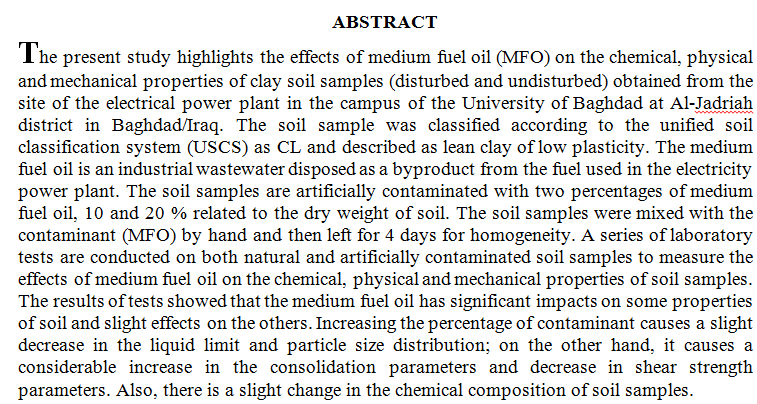
The optical properties for the components CuIn(SexTe1-x)2 thin films with both values of selenium content (x) [0.4 and 0.6] are studied. The films have been prepared by the vacuum thermal evaporation method with thickness of (250±5nm) on glass substrates. From the transmittance and absorbance spectra within the range of wavelength (400-900)nm, we determined the forbidden optical energy gap (Egopt) and the constant (B). From the studyingthe relation between absorption coefficient (α) photon energy, we determined the tails width inside the energy gap.
The results showed that the optical transition is direct; we also found that the optical energy gap increases with annealing temperature and selenium content (x). However, the width of l
Fiber reinforced polymer composite is an important material for structural application. The diversified application of FRP composite has taken center of attraction for interdisciplinary research. However, improvements on mechanical properties of this class of materials are still under research for different applications. In this paper we have modified the epoxy matrix by Al2O3, SiO2 and TiO2 nano particles in glass fiber/epoxy composite to improve the mechanical and physical properties. The composites are fabricated by hand lay-up method. It is observed that mechanical properties like flexural strength, hardness are more in case of SiO2 modified epoxy composite compare to other nano
... Show MoreBackground: Dental stone casts come into contact with impression materials and becomes susceptible to cross contamination from saliva and blood. This study was done to evaluate the physical and mechanical properties of dental stone type IV after treatments with various disinfecting agents and regimes (methods). Materials and Methods: Type IV dental stone and different types of disinfecting agents were used and divided into seven groups: G1: dental stone without disinfection (control group), G2: dental stone mixed with silver nitrate powder 0.5% , G3: dental stone mixed with silver nitrate powder 1%, G4: dental stone mixed with copper sulfate powder 0.5%, G5: dental stone mixed with copper sulfate powder 1% ,G6: dental stone immersed in prop
... Show MoreBackground: Impression materials, impression trays, and poured stone cast have been said to be the main source of cross infection between patients and dentists. However, it was observed that disinfection of the impression is not performed systematically in routine dental practice. Disinfection of alginates either by immersion or spray technique was found to cause dimensional inaccuracies, although with proper disinfection of alginates there were small dimensional changes. A variety of fluoride releasing products designed for topical use is currently available. Following their use, varied amount of fluoride is systemically absorbed depending on the fluoride concentration and the manner of its use. The objective of this study was to evaluate
... Show More (36)
(36)
 (34)
(34)
In this paper a thin films of selenium was prepare on substrates of n-Si by evaporation in a vacuum technique with thickness about 0.5μm. And then an annealing process was done on samples at two temperature (100 and 200) C ° in a vacuum furnace (10-3 torr).
Some structural, optical and mechanical properties of prepared thin films were measured. Results showed that the prepared film was the crystallization, optical transmittance and micro hardness of the prepared thin films increased significantly after annealing.
 (2)
(2)
 (1)
(1)
In the present work, pulsed laser deposition (PLD) technique was applied to a pellet of Chromium Oxide (99.999% pure) with 2.5 cm diameter and 3 mm thickness at a pressure of 5 Tons using a Hydraulic piston. The films were deposited using Nd: YAG laser λ= (4664) nm at 600 mJ and 400 number of shot on a glass substrate, The thickness of the film was (107 nm). Structural and morphological analysis showed that the films started to crystallize at annealing temperature greater than 400 oC. Absorbance and transmittance spectra were recorded in the wavelength range (300-
4400) nm before and after annealing. The effects of annealing temperature on absorption coefficient, refractive index, extinction coefficient, real and imaginary parts of d
 (2)
(2)
Abstract : Silicone elastomer is widely used as the material of choice for fabricating maxillofacial prosthesis. However, silicone properties are far from ideal; low tear strength, low tensile strength and insufficient elasticity are the most undesirable properties. The purpose of this study was to evaluate the effect of addition of nano SiO2filler on tear strength, tensile strength, elongation at break, hardness and color of Cosmesil M-511 HTV maxillofacial silicone elastomer. Nano SiO2was added to the silicone base in concentrations of 4%, 5% and 6% by weight. Silicone with 0% nano filler served as a control. Tear test was done according to ISO 34-1. Tensile and elongation test was done according to ISO 37. Shore A hardness test was done
... Show More (9)
(9)
Thin films of Nb2O5 have been successfully deposited using the DC reactive magnetron sputtering technique to manufacture NH3 gas sensors. These films have been annealed at a high temperature of 800°C for one hour. The assessment of the Nb2O5 thin films structural, morphological, and electrical characteristics was carried out using several methods such as X-ray diffraction (XRD), atomic force microscopy (AFM), energy-dispersive X-ray spectroscopy (EDS), Hall effect measurements, and sensitivity assessments. The XRD analysis confirms the polycrystalline composition of the Nb2O5 thin films with a hexagonal crystal structure. Furthermore, the sensitivity, response time, and recovery time of the gas sensor were evaluated for the Nb2O5 thin film
... Show More